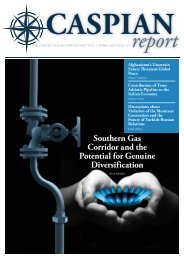You also want an ePaper? Increase the reach of your titles
YUMPU automatically turns print PDFs into web optimized ePapers that Google loves.
MANFRED HAFNER<br />
22<br />
THE DOCUMENT RECOGNIZED IN THE SOUTHERN<br />
GAS CORRIDOR ONE OF THE EU’S HIGHEST ENERGY<br />
SECURITY PRIORITIES.<br />
humanitarian crises in several Central<br />
and Eastern European countries<br />
that were strongly dependent on<br />
Russian gas supplies across Ukraine.<br />
This dispute has resulted in longterm<br />
economic consequences and<br />
affected the reputation of Russia as<br />
a reliable supplier and of Ukraine as<br />
a reliable transit country.<br />
The official document on which the<br />
Southern Gas Corridor is rooted<br />
is thus represented by the Communication<br />
delivered in 20<strong>08</strong> by<br />
the EC: the “Second Strategic Energy<br />
Review – An EU Energy Security<br />
and Solidarity Action Plan.” 2<br />
The document recognized in the<br />
Southern Gas Corridor one of the<br />
EU’s highest energy security priorities,<br />
outlying the need of a joint<br />
work between the EC, EU Member<br />
States and the countries concerned<br />
(Azerbaijan and Turkmenistan, Iraq<br />
and Mashreq countries) with the objective<br />
of rapidly securing firm commitments<br />
for the supply of natural<br />
gas and the construction of the pipelines<br />
necessary for all stages of its<br />
development. Uzbekistan and Iran<br />
were also mentioned in the Communication<br />
as potential partners, albeit<br />
only in a long-term scenario.<br />
After the release of this document,<br />
the EC invited representatives of the<br />
countries concerned to a Ministerial<br />
level meeting aimed at securing<br />
concrete progress of the initiative<br />
in May 2009. The summit, held in<br />
Prague and named “Southern Corridor<br />
- New Silk Road”, served to<br />
express the political support to the<br />
realization of the Southern Gas Corridor<br />
as an important and mutually<br />
beneficial initiative, aimed at promoting<br />
the common prosperity, stability<br />
and security of all countries involved.<br />
The countries participating<br />
at the summit declared to consider<br />
the Southern Gas Corridor concept<br />
as a modern Silk Road interconnecting<br />
countries and people from different<br />
regions and establishing the<br />
adequate framework, necessary for<br />
encouraging trade, multidirectional<br />
exchange of know-how, technologies<br />
and experience.<br />
Furthermore, the countries participating<br />
at the summit also agreed to<br />
give necessary political support and,<br />
where possible, technical and financial<br />
assistance to the development of<br />
a project already launched in 2002<br />
by a consortium composed by OMV<br />
of Austria, MOL Group of Hungary,<br />
Bulgargaz of Bulgaria, Transgaz of<br />
Romania and BOTAŞ of Turkey: 3<br />
Nabucco.<br />
THE RISE AND FALL OF NABUCCO<br />
In fact, in 2002 the five-company<br />
consortium agreed to cooperate on<br />
the development of Nabucco, a projected<br />
3,800 kilometers (km) long<br />
pipeline with a capacity of 31 billion<br />
cubic metres per year (bcm/year)<br />
designed to carry natural gas extracted<br />
in Azerbaijan, Turkmenistan,<br />
Iraq, Iran and Egypt to Southeast<br />
and Central Europe via Turkey. 4<br />
The Nabucco project immediately<br />
got an unprecedented political support<br />
from Turkey, the EU and the<br />
United States (US).<br />
2.<br />
European Commission, Second Strategic Energy Review – An EU Energy Security and Solidarity<br />
Action Plan. COM(20<strong>08</strong>) 781 final, 13 November 20<strong>08</strong>.<br />
3.<br />
The consortium was successively extended to RWE of Germany in 20<strong>08</strong>.<br />
4.<br />
Gas flows from these producing countries would have reached the Turkish border as follow: via the<br />
South Caucasus Pipeline in the case of Azerbaijan; via Iran or the planned Trans-<strong>Caspian</strong> Pipeline in<br />
the case of Turkmenistan; via the planned extension of the Arab Gas Pipeline in the case of Iraq; via<br />
the Arab Gas Pipeline in the case of Egypt.










